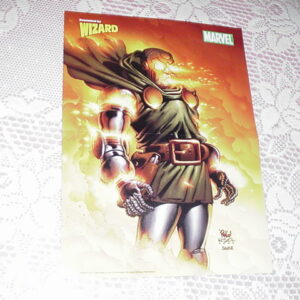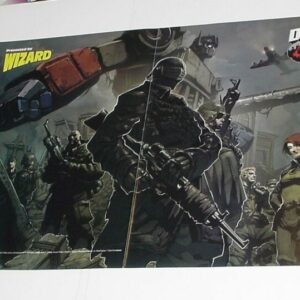Description
Superman is a superhero that appears in comic books published by DC Comics, and is considered an American cultural icon. Superman was created by writer Jerry Siegel and artist Joe Shuster, high school students living in Cleveland, Ohio, in 1933; the character was sold to Detective Comics, Inc. (later DC Comics) in 1938. Superman first appeared in Action Comics #1 (June 1938) and subsequently appeared in various radio serials, television programs, films, newspaper strips, and video games. With the success of his adventures, Superman helped to create the superhero genre and establish its primacy within the American comic book. Superman’s appearance is distinctive and iconic. He usually wears a blue costume, red cape, and stylized red-and-yellow “S” shield on his chest. This shield is used in a myriad of media to symbolize the character. The origin story of Superman relates that he was born Kal-El on the planet Krypton, before being rocketed to Earth as an infant by his scientist father Jor-El, moments before Krypton’s destruction. Discovered and adopted by a Kansas farmer and his wife, the child is raised as Clark Kent and imbued with a strong moral compass. Very early he started to display superhuman abilities, which upon reaching maturity, he resolved to use for the benefit of humanity. Superman resides and operates in the fictional American city of Metropolis. As Clark Kent, he is a journalist for the Daily Planet, a Metropolis newspaper. Superman’s archenemy is supervillain Lex Luthor. Superman has fascinated scholars, with cultural theorists, commentators, and critics alike exploring the character’s impact and role in the United States and worldwide. The character’s ownership has often been the subject of dispute, with Siegel and Shuster twice suing for the return of legal ownership. Superman placed first on IGN’s Top 100 Comic Book Heroes in May 2011. As an influential archetype of the superhero genre, Superman possesses extraordinary powers, with the character traditionally described as “faster than a speeding bullet, more powerful than a locomotive, and able to leap tall buildings in a single bound”, a phrase coined by Jay Morton and first used in the Superman radio serials and Max Fleischer animated shorts of the 1940s as well as the TV series of the 1950s. For most of his existence, Superman’s famous arsenal of powers has included flight, super-strength, invulnerability to non-magical attacks, super-speed, vision powers (including x-ray, heat-emitting, telescopic, infra-red, and microscopic vision), super-hearing, super-intelligence, and super-breath, which enables him to blow out air at freezing temperatures, as well as exert the propulsive force of high-speed winds. In the original Siegel and Shuster stories, Superman’s personality is rough and aggressive. The character often attacks and terrorizes wife beaters, profiteers, lynch mobs, and gangsters in a rough manner and with a looser moral code than audiences today might be used to.36 Although not as ruthless as the early Batman, Superman in the comics of the 1930s is unconcerned about the harm his strength may cause. He tosses villainous characters in such a manner that fatalities would presumably occur, although these are seldom shown explicitly on the page. This came to an end in late 1940 when new editor Whitney Ellsworth instituted a code of conduct for his characters to follow, banning Superman from ever killing. The character was softened and given a sense of idealism and humanitarianism. A colony of giant ants, mutated by a nuclear war on another planet, comes to Earth with a warning, and Superman uses Red Kryptonite radiation to give himself an ant’s head in order to communicate with them. Douglas Curtis Swan (February 17, 1920 – June 17, 1996) was an American comic book artist. The artist most associated with Superman during the period fans and historians call the Silver Age of comic books, Swan produced hundreds of covers and stories from the 1950s through the 1980s. Initially, Swan drew many different features, including “Tommy Tomorrow” and “Gangbusters”, but slowly he began gravitating towards the Superman line of books. His first job pencilling the iconic character was for Superman #51 (March–April 1948). Many comics of the 1940s and 1950s lacked contributor credits, but research shows that Swan began pencilling the Superboy series with its fifth issue in 1949. Swan always felt that his breakthrough came when he was assigned the art duties on Superman’s Pal, Jimmy Olsen, in 1954. In the view of comics historian Les Daniels, Swan became the definitive artist of Superman in the early 1960s with a “new look” to the character that replaced Wayne Boring’s version. Swan and writer Jim Shooter crafted the story “Superman’s Race With the Flash!” in Superman #199 (Aug. 1967) which featured the first race between the Flash and Superman, two characters known for their super-speed powers. Over the years, Swan was a remarkably consistent and prolific artist, often illustrating two or more titles per month. Swan remained as artist of Superman when Julius Schwartz became the editor of the title with issue #233 (Jan. 1971), and writer Denny O’Neil streamlined the Superman mythos, starting with the elimination of Kryptonite. Among Swan’s contributions to the Superman mythos, he and writer Cary Bates co-created the supervillains Terra-Man and the 1970s version of the Toyman as well as the superhero Vartox. Writer Martin Pasko and Swan created the Master Jailer character in Superman #331(January 1979).
Related products
-


Wolverine Poster #16 vs The Hand The End by David Finch Ninjas
$39.99 Add to cart -


Doctor Doom Poster # 3 Triumphant by Mike Wieringo Fantastic Four 67
$34.99 Add to cart -


Liberty Meadows Poster # 1 The Cow vs Brandy by Frank Cho University2
$29.99 Add to cart -


Transformers G.I. Joe Poster Pat Lee GI Optimus Prime Snake Eyes
$39.99 Add to cart


